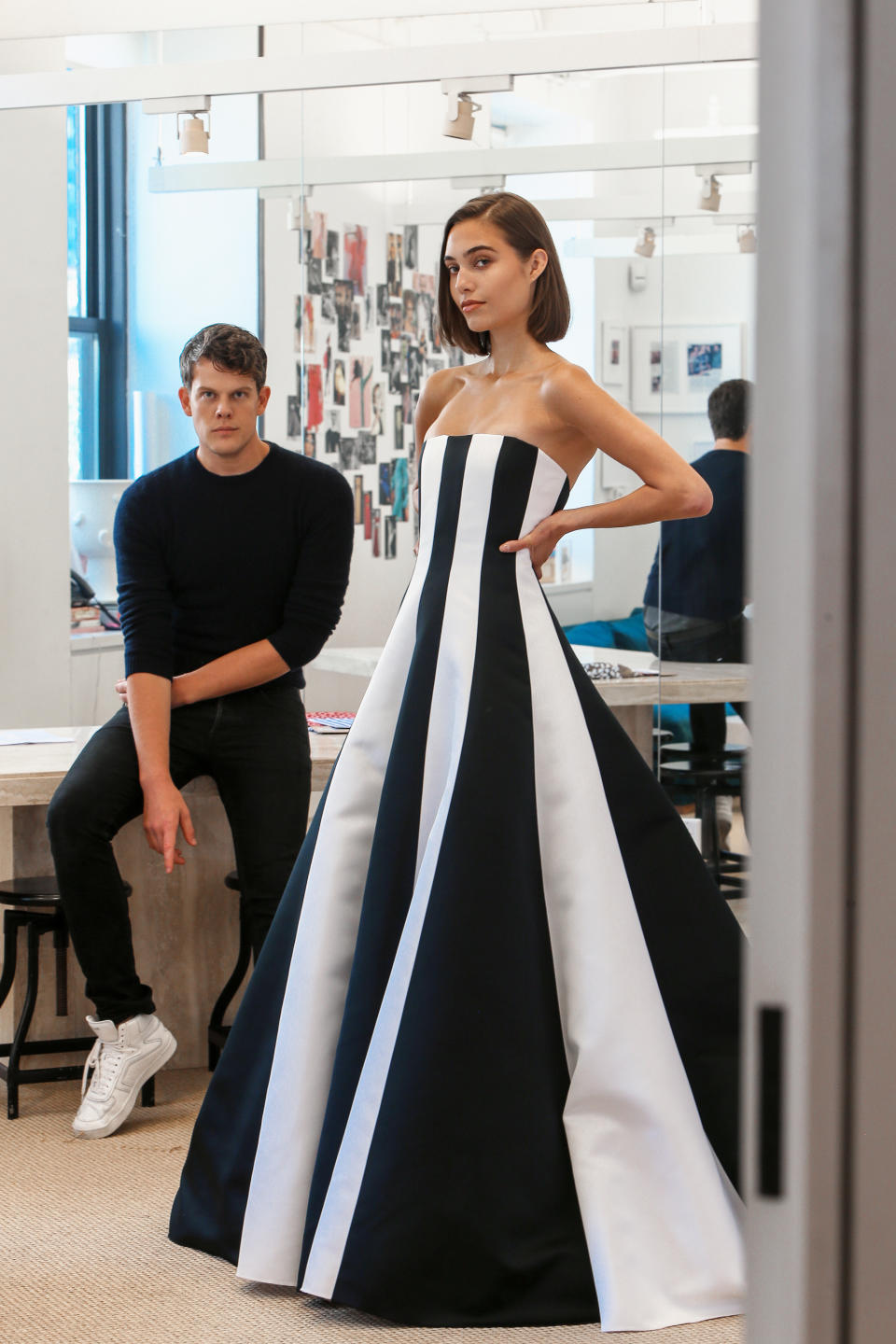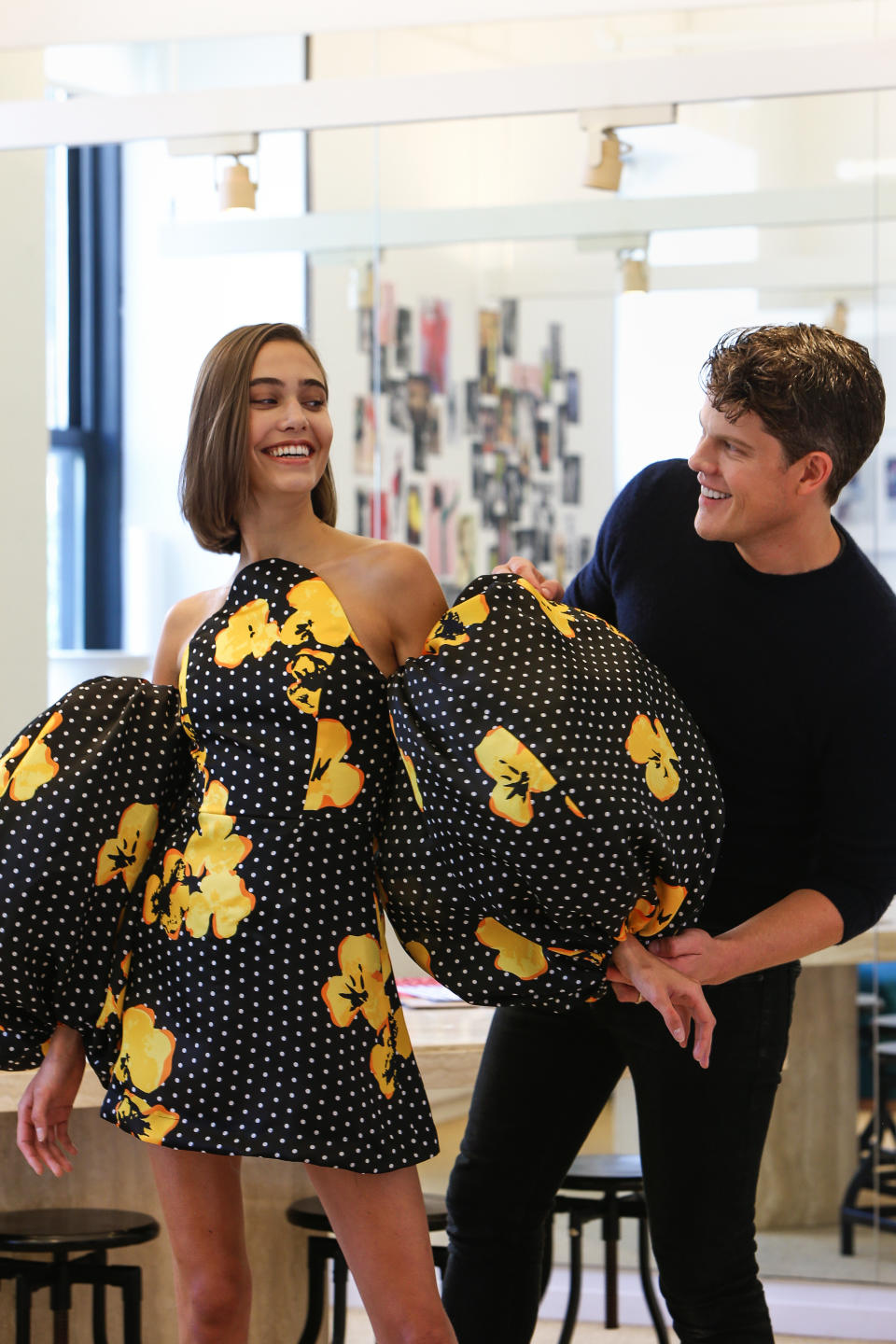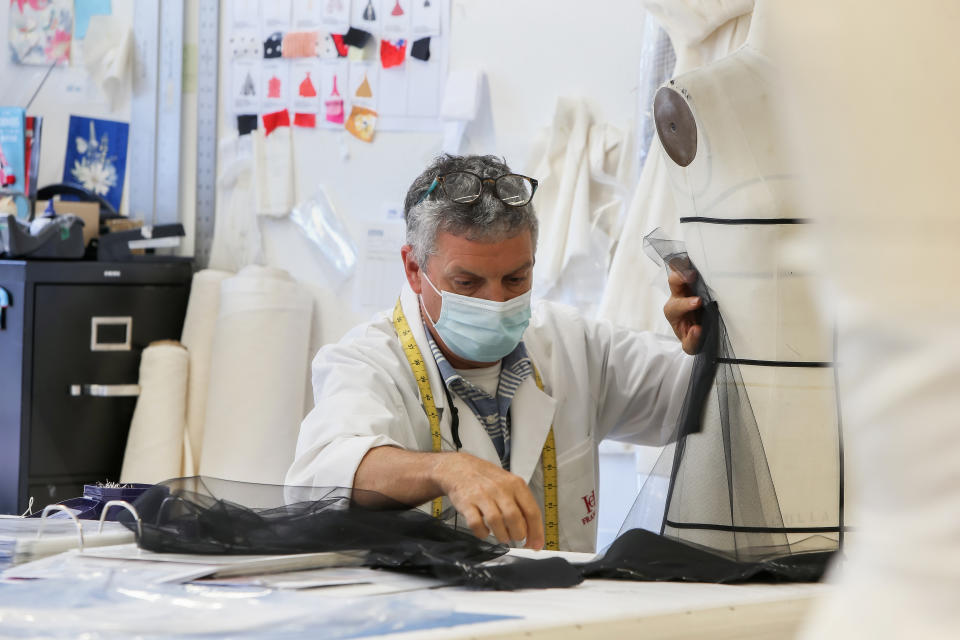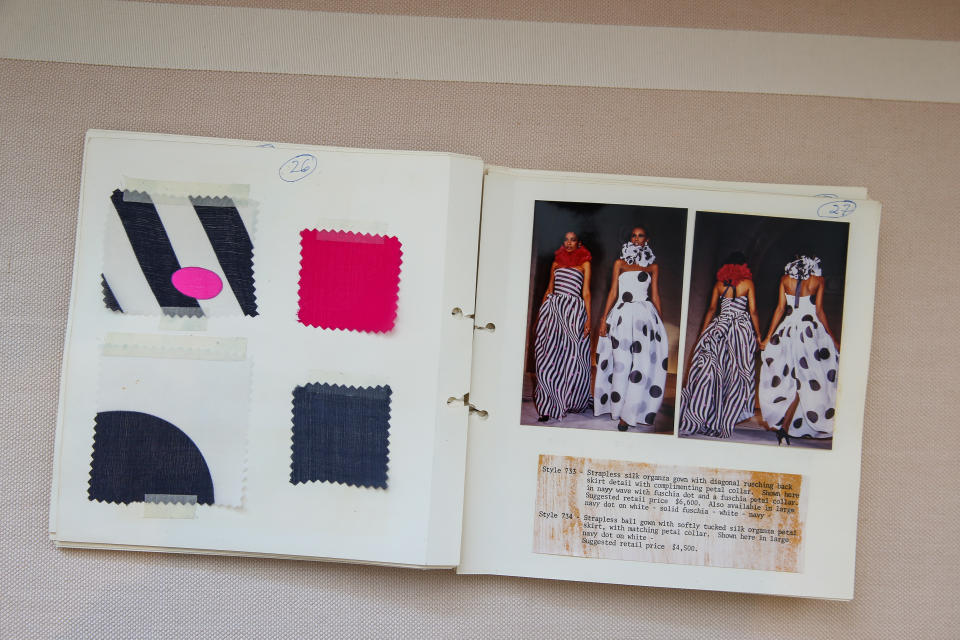Carolina Herrera and Wes Gordon’s 40 Years of Divine Decadence
- Oops!Something went wrong.Please try again later.
- Oops!Something went wrong.Please try again later.

Forty years ago, Carolina Herrera launched her fashion business with a runway show at the ritzy Metropolitan Club in Manhattan and a boldface audience that included Andy Warhol, CZ Guest, Studio 54 founder Steve Rubell, Nan Kempner and Bianca Jagger.
“It was a case for divine decadence,” WWD wrote of the fall 1981 collection, referring to Herrera as “Our Lady of the Sleeves,” and recounting how the upper-class Venezuelan sent out models in her own image, down to the “Eva Peron hairstyles.”
More from WWD

Lexie Moreland for WWD
Herrera may have been a figure on the International Best Dressed List and the New York party scene before becoming a designer, but to dismiss her merely as a socialite misses the point. She was an American female fashion trailblazer, alongside Diane von Furstenberg, Norma Kamali and others, who created a brand with aesthetic codes still recognizable today, including not only statement sleeves but statement shirts, ball skirts, polka dots and ruffles.
Over the years the crème de la crème wore her exuberant yet pragmatic designs (couture tendencies filtered through a American sportswear lens, one might say), including Jackie Onassis, Estée Lauder, and Caroline Kennedy, whose wedding dress Herrera created. First ladies and the Hollywood red carpet came calling, too.
Others enjoyed Herrera’s entrance-making drama through the moderately priced CH collection and fragrances created with Puig starting in 1988. (The Spanish fashion and beauty giant bought the brand outright in 1995).
Today, in a historically challenged fashion landscape, it’s a testament to her vision that Carolina Herrera is a 1 billion-plus euro business still standing in a city that has very few legacy brands left.
But it is her successor Wes Gordon who has steered the New York brand through the pandemic and given it 21st-century currency, channeling that divine decadence into lighter, more modern-looking party clothes and daywear embraced by the social — and social media — sets. He’s also launched beauty, turning compacts and lipstick cases into covetable accessories that can be customized with tassels and charms.
To demonstrate, perhaps, how the brand has turned a page since she handed over design duties to Gordon in 2018, Herrera has declined all press interviews around the 40th anniversary, though she continues in her role as global brand ambassador.
She will attend the spring 2022 runway show on Sept. 9 at New York Fashion Week, and remains a presence in Gordon’s life, whether it’s meeting for Sunday lunch and a trip to the museum, or ducking into the Madison Avenue boutique to shop. She recently ordered a black wool jacket with a curved neckline. “That’s important to me,” said Gordon, of her liking his clothes enough to wear them herself.
New York Pride

Lexie Moreland for WWD
Following in the footsteps of an icon whose portrait was painted by Andy Warhol couldn’t have been easy. But Gordon has made it look so with his affable, down-to-earth nature.
During a visit to the Carolina Herrera headquarters on Seventh Avenue, said portrait keeps watch over the conference room. Gordon is down to share photos of his baby Henry Eduard Arnhold-Gordon (“He’s a giant, an 11-week-old in a 6-month-old’s body”), poke fun at himself for being a new dad (“I’m drinking Red Bull, don’t judge me”) and heap praise on his husband, glassmaker Paul Arnhold (“He makes bongs for Edie Parker!”).
But make no mistake, he is serious about fashion.
“I knew I wanted to be a designer as soon as I knew that was a job you could have. I’d be drawing dresses on the margins of my math homework instead of doing the homework,” said the Atlanta native, who attended Central Saint Martins and had his own Wes Gordon label for seven years before joining Herrera. He overlapped with the founder for one year.
“What I love about being here is I feel like I have an understanding with our customer — the American woman — how she lives and what she wants. It’s that relationship between customer and design that’s very American.”
Gordon has opened the brand up to a wider world of power players, from Lena Waithe wearing a Herrera cape modeled after the rainbow Pride flag at the 2018 Met Gala to the first female U.S. vice president Kamala Harris in a suffragette white pantsuit and bow blouse for her 2020 victory speech, to reformed royal Meghan Markle in a poppy print dress urging COVID-19 vaccinations at the Vax Live concert in 2021.
“I focus on women I have an emotional connection to who are doing incredible things,” he said of his VIP strategy.
His more whimsical approach to runway has filtered down to everything from lipstick packaging to social media posts.
“In the beginning, I wanted to reinforce a bold femininity as our core ideal. I immediately banned dusty, sad, drab colors and micro prints, and everything was super caffeinated and awake,” he said. “After a couple seasons, I think it became clear we’d established that a pink at Herrera is a flamingo-hot saturated pink. Our labels used to be gray with a brown border, and we switched to red and pink. As I evolved and the more time I spent here, I better understood that fine line that made Mrs. Herrera so special — balancing avant-garde newness with timeless beauty.”
He has also moved the brand into the digital age.
“Obviously, the clothing has to be exquisite and feel incredible, but at a luxury price point that should be the norm. From there on it’s about storytelling and messaging and creating magic. That’s been something I’ve tried to focus on, not letting any shoot be taken for granted,” he said, singling out fragrance campaigns with Karlie Kloss and a recent collaboration with Interview magazine on a 40th-anniversary zine as wins.
Over the past year and half, Gordon has guided his team through five COVID-era, digital-only collections, while maintaining a level of craftsmanship that rivals European luxury houses.
“It was almost impossible to make clothes, especially a year ago, when we did our resort 2021 photo shoot and the only sign externally that COVID-19 had affected the collection was that we released the pictures four weeks late,” he said. “That’s incredible, the focus and work and organization and resilience that made it happen — pattern makers working on patterns at home, fittings over Zoom, fabric houses sending packages to my house in Connecticut, where the boxes had to sit outside for two days [for safety precautions]. The model driving in wearing basically a Hazmat suit. It was a whole new way of working but everyone was 110 percent committed in carrying Herrera forward. We didn’t miss one season. And now we’ve reached a point where we’ve grown the business.”
Making His Mark
Fashion sales are creeping back to 2019 levels, with the resort 2022 collection the biggest success yet for the brand. Gordon renovated the Madison Avenue flagship in 2019, and launched cosmetics to augment the robust fragrance business. After debuting in Europe, the beauty line is arriving in the New York store this month.
Today he will mark the 40th anniversary with the first in-person show since February 2020, staging it at the contemporary art gallery Salon 94 on the Upper East Side.
Constructed between 1913 and 1915 at 3 East 89th Street, the mansion was designed by 1900s society architect Ogden Codman Jr., who also designed a portion of the Metropolitan Club. The building first belonged to philanthropist Archer Milton Huntington, and was an artist’s studio for his wife, sculptor Anna Hyatt Huntington. Gallery owner Greenberg Rohatyn tapped Rafael Viñoly to renovate the space, which just opened this spring.
While Herrera shows typically include about 700 guests, this season there will only be 120, socially distanced in chairs throughout four rooms and two levels. Proof of vaccination and masks will be required for front and back of house.
“Everyone’s safety is the most important thing and what goes hand in hand is peace of mind and comfort level,” Gordon said. “I’ve always wanted to do a presentation on the Upper East Side because it’s so much of our DNA, it’s where Mrs. Herrera presented her first collection, where our store is and where she lives off Park Avenue, but that dream has never been a reality because of physical limitations. This time around because I was freed up a bit, we were able to find a special venue,” he explained of one of COVID-19’s silver linings.
In the Atelier

Lexie Moreland for WWD
Gordon has been back at work since June. “Within the design team, there’s a wave of optimism because for so many of us in the industry, the culmination of what we do is the fashion show,” he said, offering a tour.
Winding down the back stairs from his office to the 17th floor, he opened the door to fabric rolls, dress forms, muslins and mood boards.
“In the middle of Midtown, seven blocks from Times Square and everything that makes the city energetic and hustling is a room full of people who put on white coats and focus on all those little details that make clothes fashion,” said Gordon, seemingly still in awe himself.
Most of the atelier was at Herrera before he was, including pattern maker Francois Bouchet, a 17-year veteran, who cut the historic suit Harris wore to accept her nomination, the red tulle gown Zendaya chose from Gordon’s first collection for the 2018 MTV Awards, and many more.
“I love that he keeps in contact with Mrs. Herrera — she is transmitting who she is, what she is and he is continuing that in a more relaxed, modern and younger way,” said Bouchet, who came to the U.S. from France. “The fact that she is a woman who was the founder of the company is so important to me. She is also an immigrant — to me this is what New York means — to give opportunity to whoever wants to take it and have the chance to be recognized around the world.”
“Every pattern maker even though it’s a mathematical set of skills, has a different hand and style and flavor. After we do sketches, the next step is allocating who is going to do what. It’s almost like matchmaking,” Gordon said of the team members, who include immigrants from Ukraine, Italy and Brazil. “A sketch is a sketch but 90 percent of it is what happens in here and it’s important to match the right piece with the right person, and sometimes giving something to the not obvious person yields incredible results,” the designer said.
Taking design elements typically reserved for eveningwear and translating them to daywear has been a Gordon hallmark. “We’re making a sweater but we wanted it to have that ruffle detail we had in resort on a coat,” he said of a casual knit with a taffeta ruffle destined for the spring runway. “We couldn’t just ask our knit partners to do that and expect them to match the fabulousness of our pattern makers. So Oxana will drape and construct the ruffle, then we will stitch this to a sweater in-house to get the pattern perfect before we send it off. Just because it’s a casual piece of clothing doesn’t mean it requires less precision or time or effort or respect than a gown. And it’s just as challenging, if not more, to get it right.”
On an average week he does seven fittings, five design-related and two production fittings. “Production fittings are not a function typically attended to by a creative director, but with our size 8 fit model trying on those pieces, adapting and modifying them for production and making sure they are perfect is something I want to do. Because if you fall in love with a photo, I want to make sure it exceeds your expectations when you get it in real life,” he said with business sense.
To keep the customer dialogue going through COVID-19, he stayed on top of his DMs. “Sometimes it’s a bride asking about what earrings to wear with her gown, or a woman who sends pictures of two dresses she’s trying to decide between. I might even send a link to a third option,” he said.
The spring 2022 collection is a reflection on the past made possible by the social media present. “A woman wrote me on Instagram saying her brother had passed away, she was cleaning out his apartment and he worked at Herrera in the early ‘80s. One of the treasures she found was a scrapbook he created documenting the spring 1983 collection.”
Gordon carefully opens the book, which has the Carolina Herrera logo stenciled in gold on the cover, and is hand-bound with ribbon.

Lexie Moreland for WWD
“He put pictures of the looks, fabric swatches, run-of-show descriptions, and the prices…By the way…this jacket was $4,500 in 1983!” said the creative director.
(Herrera told WWD in 1987 that much of the beauty of her collection stemmed from the fact that she did not know the price of anything — not the fabric, nor what the clothing sold for — “I don’t get involved in that,” she said.)
Embroidered polka dots, shredded fabric flowers, seersucker suiting and spectator shoes are a few of the circa-1983 design motifs incorporated into Gordon’s upcoming collection. “It’s dramatic, bold and fearless in the same way those early ’80s party pictures were,” he said, referring to Herrera’s Studio 54 heyday.
Bringing it back to the 40th anniversary, he said, “One of the first compliments people give to Mrs. Herrera is how elegant she is in her personal style; but what’s often overlooked is her brilliance as a designer. One idea of hers I love is that the bravest thing is to be beautiful and elegant. In an industry that’s so much about what’s next, without always the objectivity of is this good or right, that point of view is rebellious and courageous. I like to keep it in mind.”
Launch Gallery: From the Archive: Carolina Herrera Through the Years
Best of WWD
Sign up for WWD's Newsletter. For the latest news, follow us on Twitter, Facebook, and Instagram.

